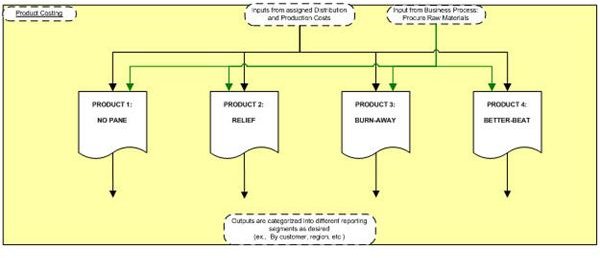Providing a Glossary of Cost Accounting Terminologies: A Beginner's Guide
A Cost Accounting Glossary for Cost Accounting Concepts
This Glossary of Cost Accounting Terminologies provides definitions of words commonly used in manufacturing concerns. It’s a one-stop resource for definitions of cost accounting methods and components. As a beginner’s guide, explanations aside from formulas will help the learner grasp the rationale behind each concept.
Use this glossary as an easier route to learning about cost accounting terms, which tend to be tricky as they may look and sound the same. A quick comparison of those cost accounting terminologies shows that a title or phrase can easily take on a new meaning if another word is added or replaced. In some cases, a concept or methodology goes by a different title.
I_mage Credit: ROSA Fig11 courtesy of Wikimedia Commons_
Cost Accounting Terminologies: Beginning with A

Absorb – Cost accounting term to denote that a cost originating from one unit is being assigned or attributed as part of the overhead costs of the different production units. That way, a more realistic calculation of cost distribution can be achieved.
Absorption Costing – A cost allocation method of taking into account the company’s indirect costs and allocating a certain proportion as part of the direct factory overhead costs of the manufacturing sector.
Activity-Based Costing or ABC – An accounting method of identifying all the cost drivers and their relevant activities for the purpose of determining where all the indirect costs can be proportionately distributed as part of the direct costs. The aim is to arrive at a more accurate calculation for product costing.
Activity Accounting – This is a type of accounting wherein each department must financially account for and report their contributions and participation in the incurrence of costs and generation of revenues. That way, management can easily pinpoint which unit is being managed efficiently as contributors to or as burdens of the entire business process.
Activity Analysis – Evaluating the man-hours used and the related costs incurred within a cycle-time, by each unit in a decentralized organization. Activity analysis requires the computation of each sector’s contributions, relevance, the values added, and the impact of their performance in the entire business process.
Activity Attributes – The mention of activity attributes refers to the method of identifying the activity in terms of its capacity, of its attributes as a cost driver, and the duration of the cycle-time, or any other characteristics that can identify the relevance and proportion of a particular activity to another unit/units or cost components.
<strong>Activity Base</strong> – The matter of taking into account the different activities considered as factors that create impacts on the results of the business process. This is done by identifying which units, components, or products are performing as cost drivers. In this kind of set-up, management can implement measures to streamline the activities of certain sectors that tend to drag down the contributions provided by the profit generators.
Activity Capacity – The process of determining the expected capacity in terms of output rate produced, if the work is performed under normal operating conditions using a pre-determined amount of resources and within a reasonable length of time.
Activity Center – These are units of work centers where activities are performed and for which the amount of resources used have considerable relevance and effect in determining the cost of production.
Activity Cost Driver – These refer to the factors in an activity center that create a change in a particular activity’s manner of consumption. Such changes tend to affect the amount of available resources, as they are used up by centers in the process of contributing to the entire business cycle. Some examples of cost drivers include the machineries employed, the operator of the machinery, the area occupied, the energy consumed, or the waste outputs.
Activity Cost Pool – The summation of all the cost factors present in a particular activity.
Activity Level – The degree by which a product as a cost object, or another activity involved in the manufacture of a product, uses its resources to attain its goals.
Actual Cost – This refers to the definite and specific amounts paid or incurred for direct labor, direct material, and such other charges that are directly related to production.
Applied Cost – A reference to this term denotes the predetermined or pre-assigned costs designated to each component, whether for a particular activity, a unit, or a product in which estimates are not necessarily based on actual costs.
The next page: contains cost accounting terminologies beginning with B-C-D.
Cost Accounting Terminologies: Beginning with B-C-D

Balanced Scorecard -- Tool used as performance metrics or measures of performance based on the manufacturing company’s goals and on industry benchmarks.
Base Stock Method – Base stock refers to the minimum inventory level needed and deemed practical for efficient business operations, in which the method makes use of actual price plus LIFO for all succeeding inventory costs. Under the GAAP rules, this is not generally accepted as a sound cost accounting system.
Batch Activity – A method of cost allocation in which the distribution of resources is based on the number of batches produced instead of the number of units contained in each batch.
Benchmark – A set of industry standards derived from the results of studies pertaining to the performance of successful industries in the sectors they represent.
Break-even point – A level where the amount sales attained is met with the same amount of costs, thus resulting in zero profit.
Budgeted Cost – Planned or pre-determined cash outlays used by management as a tool for controlling the costs within the boundaries of the projected or forecasted profit margin.
Burden/Burden Cost – In cost accounting, the concept of burden refers to a load or cost that is distributed as part of the costs incurred by the revenue generators.
Burden Rate – The basis by which burden cost is allocated and is usually derived by the proportion of the manufacturing department’s direct labor hours over the total direct labor hours of the entire production plant.

Control/Controlling – This is the concept of implementing procedures that would keep the operations running within a set of pre-determined plans and then monitoring the variances and feedbacks, as a means of ensuring that all processes are working efficiently and effectively toward the attainment of the business goal.
Contribution Margin – This refers to the profit margin after deducting the variable costs from the sales revenues. This amount determines the limits by which the fixed costs can be incurred; also known as marginal profit.
Cost-Volume Profit – A depiction of the relationship between the cost, the volume, and the profit attained for a specific activity, presented in graph form.
Cost Center – This refers to that sector in a business organization that undertakes the implementation of cost control procedures by monitoring and analyzing the deviations from standards that may affect the company’s attainment of business goals.
Cost Accounting – This is a specialization in the field of accounting that has more focus on rendering accounting services that will provide management the financial data related to product costs, as bases for determining the product’s selling price.
Cost of Goods Sold – The financial statement presentation of the cost of the goods available for resale, which includes the year’s beginning inventory plus total purchases, and then deducting the actual goods remaining or on hand.

Differential Cost – A cost that can be avoided by considering its relevance. If necessary, management may decide to use alternative means.
Direct Allocation Method – The process of allocating or apportioning the costs incurred by each service unit to the production unit in addition to the latter’s overhead. This is without taking into consideration the service provided by one service unit to another. The overhead cost incurred by the plant maintenance facility, as an example, will be absorbed by the assembly and the machinery units in proportion to the man-hours they employ in their functions as production departments.
Direct Cost – This refers to the direct charges, like costs of materials and cost of labor, as they are used for production, or any direct charges directly incurred in any activity related to production or to the performance of service.
Direct Labor – The costs and the number of hours performed by an employee in relation to a specific product or service, or to a cost center, or for a specific job order.
Find more cost accounting terminologies on the next page, continuing with D.
Continuation of Cost Accounting Terminologies: Continuing with D

Direct Labor Efficiency Variance Analysis – This is the measure of efficiency in harnessing man-hours employed in the production of a particular product in relation to the number of units generated. A standard labor time is deemed as reasonable to produce goods that are highly acceptable to consumers; hence any resulting direct labor variance will have to be analyzed not by the number of hours used for production but by the effects created by the variance.
Direct Labor Time Standards – This refers to the time budgeted or allotted as reasonable for each unit, i.e. a machine, a batch, a specific process, or a department, to perform and complete the processes involved for an output to be generated.
Direct Labor Variance – The difference between the actual hours employed for a particular production activity against the direct labor time standards established for that same production activity. Determining this variance will provide the variable for computing the rate of direct labor efficiency and its analysis.
Direct Material – The actual measure and cost of materials that directly enter the production processes of a particular product.
Direct Materials Price Standard – This is the established cost of material deemed as adequate to produce a single unit of the product for which the standard price is established. Determining the standard price of materials takes into consideration the costs incidental to its procurement, i.e. shipping, holding, allowances for quantity differentials, and the net discounts.
Direct Materials Price Variance – This refers to the difference between actual price of direct materials used for a product and the standard cost of direct materials set for the same product.
Direct Materials Price Variance Analysis – The factors that gave rise to the variance are analyzed by isolating the point of operations at which the deviation from standards begins to take place. In cases where deviations arise, the sources of data to support and explain the occurrence of the variances will come from the purchasing unit, the procedures employed, the suppliers, the quantity ordered and delivered, as well as the quality of the raw material. This is regardless if the variable derived is favorable or unfavorable.
Direct Materials Quantity – The actual measure of direct materials that enter into the production processes.
Direct Materials Quantity Variance – The difference between the actual quantity used and the standard quantity of material per unit of a specific product.
Direct Materials Quantity Standard –The amount or measure of materials established as adequate for the production of a particular product, which takes into consideration the wastes, rejects, errors, and similar inefficiencies that are considered as normal under regular conditions.
Direct Materials Yield Variance – The comparison between the standard costs quantified by the standard number of output as against the standard cost quantified by the actual number of output. The resulting difference is the variance in yield or the variance in the quantities of outputs produced.
Direct Costing Method – Term used for cost allocation in a manufacturing concern, wherein services rendered to benefit another service department is not taken into consideration. Instead, the entire cost identified in each service department is directly allocated for absorption of the different production units, in proportion to the direct labor employed by each production processor. Although criticized, direct costing method is widely used because of its simplicity. This is also known as absorption costing and marginal costing method.
Disposition of Variances – Under the standard costing method, variances that are attributable to manufacturing performance shall be disposed by including them in the profit and loss summary. In which case, unfavorable variances will be recognized as loss while favorable variances shall be added to the gross revenue based on standard costs. In some cases, the dispositions of variances are imputed against the cost of goods sold.
Distributed Processing – This is the adherent concept for the process costing method, which largely depends on the procedure adopted, whether by absorption costing, in which both fixed costs and variable costs are taken into account, or marginal costing, in which only the variable costs are considered. See Process Costing Method, Absorption Method and Marginal Costing.
Distribution Cost – This refers to the cost incurred by the business from mobilizing its goods from different points of production through the point of consumption.
The next page contains cost accounting terminologies beginning with E-F.
Cost Accounting Terminologies: Beginning with E-F

Estimated Cost – This refers to the calculations of the total probable costs of a project, a product, or any form of undertaking based on available data using any of the following concepts: planning estimate, budget estimate, cost-data based on established rules, and not-to-exceed the minimum or maximum rules.
Expected Actual Capacity – This refers to the estimation of the amount to be produced within a specific period and within the boundaries of certain limits as presented by the availability of capital, space, machinery, materials, or labor. As a measure of expected capacity, these are expressed in terms of units, weight, dollar value, or man-hours.
Expected Annual Activity – This estimation refers to the expected level of production for the succeeding year, which basically takes into consideration the anticipated market demand for the said year.
Expected Monetary Value – This refers to the probability of incurring a gain or loss in the manufacture of a product.
Expected Time for an Activity – This concept takes into consideration the factors that can affect the plan of activities for a particular product or project, even if there is optimism that all other related activities may be expected to attain completion at an expected time. These include factors such as the availability of raw materials during their stages of production and how weather conditions can alter the costs of these materials as supply becomes scarce. They are examples of critical points to consider for the expected time of activity. See Program Evaluation and Review Technique (PERT) Analysis.
Expected Value – This refers to the weighted average of the possible variables and the range of possibility that these variables may occur.

Factory Burden – This is commonly known as factory overhead, which represents the entire cost incurred by the manufacturing department less the direct labor and direct materials. Some items included are cost of machinery depreciation, cost to set up, cleanup costs, quality costs, employer’s related contributions to the payroll taxes, supplemental benefits, and other such costs allocated to the work-in-process.
Factory Ledger – Refers to the segregation of all accounts used to record factory-related expenditures in order to monitor the different manufacturing costs, e.g. direct materials, direct labor, and factory burden or overhead costs.
Factory Overhead – See Factory Burden
Factory Overhead Budget – A system by which the indirect costs such as indirect materials, indirect labors, factory maintenance, and factory insurance, regardless if the costs are fixed or variable, are planned and scheduled according to expected costs and conditions by way of estimates.
Failure Costs – These represent the costs incurred if the manufactured product or services rendered do not meet the required quality, which are determined internally or externally. Internal factors failure costs are the scraps produced at more than the expected amounts or the costs of re-working the product while external costs stem from customer complaints leading to a return of defective items and lost sales.
Finished Goods Inventory – Goods classified under this inventory are those that have undergone the complete process of production and are awaiting sale or distribution to the resellers.
First-Stage Allocation – This refers to the process by which the factory overhead costs that are traced in the general ledger accounts and originating from different resources are transferred to the activity cost pool in accordance with a system that employs an activity-based costing method. Others use the term resource cost allocation.
Fixed Factory Overhead – These are the factory overhead costs that remain stable regardless of the volume or quantity of products manufactured and for a specific period of time. Examples of these fixed costs include rent, production supervisors’ salaries, depreciation, or insurance.
Fixed Overhead Spending (Budget) Variance – This variance is calculated by extracting the difference between the actual fixed-factory overhead against the budgeted amount of fixed overhead costs. This is to determine the efficiency of other sectors not directly involved with production, in maintaining their cost contributions at acceptable levels based on standard costs.
Flexible Budget Formula – This is also known as the cost-volume formula, which comprises budgets that are developed according to the measure of various levels of activities in a manufacturing concern.
Flexible Budget Variance – Any such difference between the actual factory overhead costs as against the budget developed based on volume levels is considered flexible budget variance.
Flow Process Chart – This refers to the depictions of the flow of processes according to their order of sequences from the areas of operation, to inspection, transfers, and distribution, including storage and the occurrences of delay as they happen.
Find cost accounting terminologies beginning with I-J-M on the next page.
Cost Accounting Terminologies: Beginning with I-J-M

Indirect Cost – This refers to expenses that are transferred into the activity cost pool and will form part of the manufacturing overhead costs. They are costs that are not evidently seen as entering the process of production but their incurrence is with a direct relevance to the manufacturing processes. Examples of indirect costs include electricity, insurance costs, or taxes.
Indirect Labor – Salaries of factory employees that are not charged to the finished product but are allocated or apportioned according to their respective service department or to the direct labor cost, which calls for their services. Inspectors, warehouse personnel, or maintenance are only some examples.
Indirect Material – these are material purchases and supplies that do not enter the actual process of production, although they have an indirect relevance to the procurement, management, or maintenance of the direct material and direct labor costs.
Input Cost – A reference to input costs denotes the entire amount attributed to the manufacture of the goods or services, i.e. direct materials, direct labor, and factory overhead costs.
Input-Output Analysis – This is an economic concept developed by Wassily Leontief, based on the premise that the matter of consumption by each sector influences the demand of another sector. Based on this, it is perceived that one sector’s output becomes the other sector’s input; thus, there is an existing economic interdependence wherein one industry’s ability to supply can affect another industry’s demand for a product, or vice-versa.

Job Order Costing – This is a method of costing commonly used by custom manufacturers like aircraft manufacturers, automobiles, printers, and other professional service providers. Direct material and labor costs are traced and attributed to a particular job order while the overhead costs are attributed to a particular job based on a predetermined overhead rate.
Job Cost Sheet – A form used to provide in detail the cost and type of materials, the cost of labor, and the indirect costs that will be utilized and employed to finish a specific job order.

Managed Cost – This is the cost accounting term for Discretionary Cost.
Manufacturing Cells – A group of different machines used for the production of a particular product that are strategically laid out together, usually in a semi-circular set-up with the objective of allowing free-flowing movement for its operators and support workers. Those handling the work-in-process are multi-skilled, thus able to perform in a work set-up that maximizes time and space where tools and materials can likewise be strategically located closer or at hand in order to complete the production process within the cell.
Manufacturing Cost Flow – The stream of work processes and the transition of all related production costs from its procurement and delivery, to inventory releases, and transfer from one work-process to another, into becoming finished goods inventory through its final accounting as a cost of goods sold.
Manufacturing Costs – The entire cost of manufacturing a product as it comprises direct labor, direct materials, and factory overhead.
Manufacturing Cycle Efficiency (MCE) – As efficiency denotes optimized use of resources in a given period of time, the MCE concept measures the time value needed to produce quality products in a particular work-cycle period or the total time cycle.
Manufacturing Cycle Time – This pertains to the delay met by production from point of order through its completion process. This is also known as manufacturing lead time or thoughput time.
Manufacturing Expense- See Manufacturing Costs
Manufacturing Lead Time – See Manufacturing Cycle Time
Manufacturing Overhead – See Factory Burden
Materials Price Variance – The difference between actual costs of materials against standard price multiplied by the actual quantity.
Materials Purchase Price Variance – The difference between the specific actual purchase prices of materials against the standard price multiplied by the actual quantity purchased.
Materials Quantity (Usage) Variance – The difference between the actual quantities of materials used compared to the standard quantity of materials use multiplied by the standard price per unit. Analysis of variances may translate excess quantity as favorable and less than standard as unfavorable but requires further investigation into its root causes.
Mixed Cost – This description denotes the combined costs of the fixed and variable components of a product.
Moving Average Inventory – A procedure observed when the perpetual inventory system is employed, which requires the system to generate a new weighted average cost to be calculated after every purchase.
The next page contains the cost accounting terminologies beginning with N-O-P-R.
Cost Accounting Terminologies: Beginning with N-O-P-R

Non-Controllable Cost – Costs that can be affected by other factors that cannot be directed to take a course in accordance with management’s supervisory functions. Some examples of non-controllable costs are the rental costs and salary of workers.
Normal Capacity – The quantity of production that can be attained, which is expressed in terms of units, size, man-hours, dollar values, or labor costs, within a maximum limit in terms of available space, machinery, labor, material, or capital.
Normal Costing – Also known as normal absorption costing as this method comprises actual costs of direct materials and direct labor used plus the costs of factory overhead costs allocated, using pre-determined overhead rates quantified by multiplying the unit cost by the actual units of inputs.

Outlay – The amount of money spent as cost.
Overhead – These are the costs mainly used for administrative functions that cannot be directly attributed as part of a particular business activity but are technically incurred in relation to the factors that arise from such activities; hence they are deemed as necessary costs that are properly allocated by means of a pre-determined set of rates.
Different terminologies are being used to denote these costs, which include factory burden, factory overhead, and manufacturing overhead, just to name a few.

Periodic Inventory System – This is a system of monitoring inventory levels by manually recording the releases and deliveries on individual stock cards. Periodic inventories are conducted to monitor stock levels for requisition and replenishment purposes. At the end of the year, the actual inventory including those displayed on stock shelves will be physically counted and accounted, for purposes of determining the cost of goods sold.
Perpetual Inventory System – This is a method of monitoring the inventory of goods for resale by using an electronically installed system in the cash registers or business machines. Each product sold will be automatically deducted from the inventory count thereby perpetually keeping the inventory records up to date, as far as releases are concerned. Purchases, on the other hand will be recorded administratively and the increment will likewise be taken up in the electronic inventory system. Although this system automatically generates an ending inventory report at the end of the year, a physical count will be conducted to verify and confirm the stock balances.
Process Costing - A method of cost allocation largely used by companies involved with the manufacture of continuous volume of units that undergo a series of processing. Each processing unit or activity center aggregates its manufacturing costs, whereby the unit cost is determined based on the quantity it produces as output. Thereafter, the unit cost of each processing sector will add up as the aggregate unit cost of the product sold.
Program Evaluation and Review Technique (PERT) – A management tool deemed useful for planning, coordinating, and controlling the complexities of large projects like building constructions or computer installation, including the accounting process of closing of books. Its main component is the formulation of a Master Budget.

Raw Materials – These are the materials referred to as direct costs since they directly enter the process of production through its completion as finished goods.
Raw Materials Inventory – This refers to the supply of raw materials on hand and still maintained inside the stockroom/s.
Raw Materials-in-Process – This refers to the raw materials issued to the production department that was accounted for during year-end closing procedures as part of the inventory but was already being processed for production at the time of physical inventory.
Responsibility Center – In a decentralized system of accounting for costs, each segment of the business process is referred to as responsibility center for purposes of cost accounting.
Find cost accounting terminologies beginning with S-U-V-W on the next page.
Cost Accounting Terminologies: Beginning with S-U-V-W

Standard Cost – The pre-determined costs at which goods or services are expected to be manufactured or delivered under normal conditions, where extraordinary occurrences do not form part of the considerations. They are based on historical costs and studies of time and motion observations and are therefore considered as a reasonable set of values to aim for as targeted goals.
<strong>Standard Cost System</strong> – This is a kind of framework within which the production units of a manufacturing concern perform their areas of responsibility. The costs of incurring their outputs are predetermined by a set of values by adhering to budget plans, as this provides management with a ready set of references to gauge the performance of each unit.
Standard Cost Variance – This refers to the comparison between the actual revenue, costs, and net profits realized and the pre-determined values in the master budget plan. Both favorable and unfavorable differences shall be analyzed and each of the responsibility centers will furnish explanations as to the causes of the deviations created by their performance.
Standard Deviation – This refers to the expected volatility of a particular component in relation to its ability to perform within a set of pre-determined conditions.

Unit Cost – The least measure of unit for a given product and the equivalent costs used for its production.
Units of Production Method – This is a method of depreciation in which a fixed rate of cost per unit is determined by estimating the number of product units that the fixed asset will produce during its estimated useful life. Thereafter, depreciation costs will be allocated by multiplying the fixed rate of depreciation by the actual number of product units produced.
Variable – A quantity that is not expected to be constant or fixed but is expected to change.
Variable (Factory) Overhead – These are indirect costs that are expected to change from time to time.
Volume – In terms of measurement, this is described as a unit of three-dimensional measure of space comprising length, width, and height and expressed as cubic meters, cubic inches, or cubic feet.
Weighted Average – A method of calculation that sums up the values of different data, where each value is given different weights to indicate its respective importance in its data category. An example of a system where the weighted average calculation is used is in the perpetual inventory system, in which prices of purchases vary and the value of each price will be given weight according to the quantity of unit stocks purchased.
Workflow – A sequence of processes in which the goods or objects being processed transfer from one stage to another, from their entry into the work cycle through their stage of disposition.
